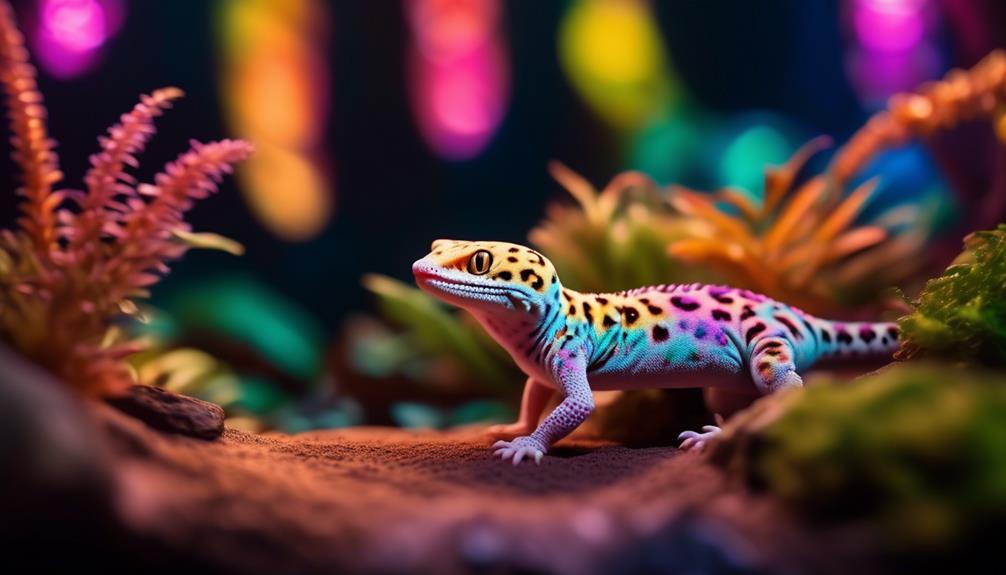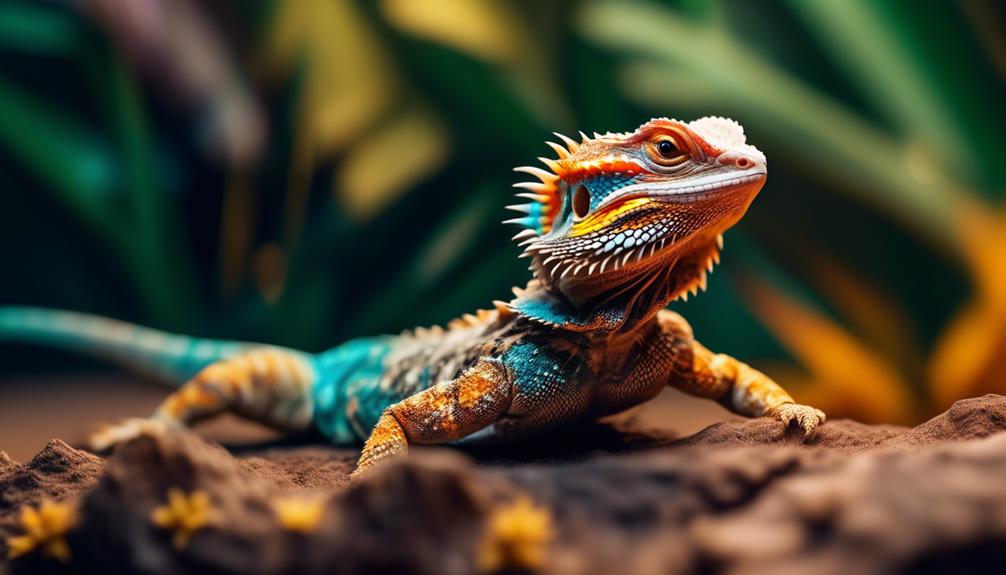Are you curious about the intricate mating rituals of blue-tongued skinks? Look no further! This article delves into the signs, behaviors, and timing of their fascinating courtship.
Discover the physical cues that indicate mating readiness, observe the intricate courtship behaviors, and gain a deeper understanding of their reproductive cycle.
Explore the environmental factors that influence their mating habits and learn about the timing and frequency of these captivating rituals.
Prepare to be enlightened by the world of blue-tongued skink mating!
Key Takeaways
- Physical cues such as enlarged testes in males and a bulging abdomen in females indicate readiness for mating in blue-tongued skinks.
- Courtship behavior in blue-tongued skinks involves various displays, such as head bobbing by males and tail wagging by females.
- The timing and seasonal patterns of courtship activities in blue-tongued skinks are influenced by geographic location, climate, and reproductive state.
- Environmental factors such as hormonal changes, temperature variations, and food availability play a crucial role in the mating behavior and reproductive cycle of blue-tongued skinks.
Physical Cues for Mating Readiness
To determine if your blue-tongued skink is ready to mate, look for specific physical cues. Mating behavior in blue-tongued skinks is often triggered by the breeding season, which typically occurs during spring and summer. During this time, males and females will exhibit certain physical changes to signal their readiness to breed.
One of the key physical cues to look for is the enlargement of the male's testes. As the breeding season approaches, the testes will become larger and more visible. Additionally, males may display increased aggression towards other males and engage in territorial behavior to attract females.
Females, on the other hand, may develop a bulging abdomen as a result of the developing eggs. They may also exhibit a change in behavior, becoming more receptive to male advances and displaying a willingness to mate.
Courtship Behavior of Blue-Tongued Skinks
When it comes to the courtship behavior of Blue-Tongued Skinks, several mating rituals have been observed. These rituals include various courtship displays, such as head bobbing, tongue flicking, and tail wagging, which are performed by both males and females.
The timing of courtship activities is often influenced by factors such as temperature and availability of food.
Mating Rituals Observed
The blue-tongued skink displays unique courtship behavior during mating rituals. These behaviors are particularly prominent during the breeding season. Here are some fascinating observations:
- Head bobbing: Male skinks bob their heads up and down in a rhythmic motion to communicate their interest and establish dominance.
- Tail wagging: Females often respond to the male's head bobbing by wagging their tails from side to side. This signals their receptiveness and willingness to mate.
- Tongue flicking: Both males and females engage in tongue flicking, which involves rapidly flicking their tongues in and out of their mouths. This behavior is believed to facilitate communication and chemical sensing.
- Chasing and biting: During courtship, males may chase the females and gently bite their tails or limbs. While this may seem aggressive, it's a normal part of the mating ritual.
Understanding and appreciating these intricate mating behaviors can help us better serve the blue-tongued skinks in captivity and promote successful breeding outcomes.
Courtship Displays Explained
You can witness the fascinating courtship displays of blue-tongued skinks as they engage in intricate behaviors to attract and bond with a potential mate. Courtship displays are a crucial part of the mating ritual, serving as a way for the skinks to communicate their readiness to mate.
These displays involve a combination of visual and behavioral cues that indicate the skink's mating readiness. The male skink typically initiates the courtship display by approaching the female and performing a series of movements and gestures. These may include head bobbing, tongue flicking, tail wagging, and body undulations.
These behaviors are meant to capture the female's attention and signal the male's fitness as a potential mate. The courtship displays of blue-tongued skinks are a captivating sight, showcasing the unique and intricate behaviors that play a vital role in the mating process.
Timing of Courtship Activities
During courtship, blue-tongued skinks engage in a series of behaviors, such as head bobbing and tail wagging, to establish mutual attraction and readiness to mate. Timing plays a crucial role in courtship activities, as blue-tongued skinks have specific mating season patterns.
These patterns vary depending on the geographic location and climate. For example, in some regions, mating season occurs during the spring, while in others, it may be in the summer or fall.
Courtship duration analysis reveals that the entire courtship process can last from a few minutes to several hours. This extended period allows the skinks to assess each other's suitability as potential mates.
The timing of courtship activities ensures that the skinks are in the optimal reproductive state and increases the chances of successful mating.
Understanding the Reproductive Cycle
To fully comprehend the reproductive cycle of blue-tongued skinks, it's crucial to familiarize yourself with their mating rituals and behaviors.
In terms of reproductive cycle variations, blue-tongued skinks exhibit a seasonal reproductive pattern. This means that their mating activities are regulated by changes in environmental factors such as temperature, photoperiod, and food availability.
During the breeding season, which typically occurs in spring or early summer, there are distinct hormonal changes that take place in both males and females. Males experience an increase in testosterone levels, which stimulates the development of secondary sexual characteristics and triggers courtship behaviors.
Females, on the other hand, undergo a rise in estrogen levels, preparing their reproductive system for mating and egg production.
Understanding these hormonal changes is essential in predicting and managing the breeding behavior of blue-tongued skinks.
Environmental Factors Influencing Mating
Sometimes, environmental factors can greatly influence the mating behavior of blue-tongued skinks. These factors include temperature variations and food availability.
- Temperature variations: Blue-tongued skinks are ectothermic reptiles, meaning their body temperature is regulated by their environment. When the temperature is too low, they may not have enough energy for mating. Conversely, if the temperature is too high, it can cause stress and reduce the likelihood of successful mating.
- Food availability: Adequate nutrition is essential for blue-tongued skinks to reproduce successfully. A lack of food can lead to reduced energy levels and poor overall health, making them less likely to engage in mating behaviors. On the other hand, a plentiful food supply ensures optimal health and energy levels, increasing their likelihood of successful mating.
Understanding and managing these environmental factors can greatly enhance the chances of successful mating in blue-tongued skinks. By providing suitable temperature conditions and a well-balanced diet, you can create an environment that promotes and supports their reproductive behaviors.
Mating Rituals and Interactions
Have you ever wondered how blue-tongued skinks engage in their mating rituals and interactions, and what role they play in the reproductive process? Blue-tongued skinks, like many other reptiles, have developed unique ways to communicate during mating. They use a combination of visual displays, body movements, and chemical signals to attract potential mates. One important aspect of blue-tongued skink communication is the use of pheromones. Pheromones are chemical substances secreted by individuals that can influence the behavior of others of the same species. In the case of blue-tongued skinks, pheromones play a crucial role in attracting mates and indicating receptivity for mating. These chemical signals are detected by the vomeronasal organ, a specialized sensory organ located in the roof of the mouth. By understanding the role of pheromones in mating, we can gain insights into the complex communication strategies of blue-tongued skinks.
| Mating Rituals | Interactions | Role of Pheromones |
|---|---|---|
| Visual displays | Body movements | Attraction |
| Courtship dances | Socializing | Receptivity |
| Head bobbing | Competition | Mating readiness |
| Tail flicking | Territoriality | Communication |
Timing and Frequency of Blue-Tongued Skink Mating
If you're curious about when and how often blue-tongued skinks mate, it's important to understand their reproductive patterns and behaviors. These fascinating reptiles have specific mating seasons and follow distinct breeding patterns.
Here's what you need to know:
- Mating Season: Blue-tongued skinks generally mate during the spring and summer months when the weather is warmer and food is plentiful. This is when their hormone levels rise, signaling their readiness to reproduce.
- Breeding Patterns: Blue-tongued skinks are known for their monogamous mating behavior. Once they find a suitable partner, they'll engage in courtship rituals, such as head bobbing and tail chasing, to establish a connection and determine compatibility.
- Frequency: Blue-tongued skinks typically mate once a year, during the mating season. However, if the female doesn't become pregnant, she may go into a second mating cycle later in the season to increase her chances of reproduction.
Understanding the timing and frequency of blue-tongued skink mating can help enthusiasts and breeders provide the optimal conditions for successful reproduction.
Frequently Asked Questions
How Long Does the Mating Process of Blue-Tongued Skinks Usually Take?
During blue-tongued skink mating, the mating duration can vary depending on factors such as the individuals involved and environmental conditions. Understanding the mating rituals and behavior of these skinks can provide insights into their overall reproductive process.
Do Blue-Tongued Skinks Display Any Specific Behaviors During Courtship?
During courtship, blue-tongued skinks exhibit specific behaviors. These include head bobbing, circling, and tail wagging. Males often display their bright blue tongues as a sign of dominance and to attract potential mates.
Can Environmental Conditions Affect the Breeding Season of Blue-Tongued Skinks?
The breeding season of blue-tongued skinks can be impacted by environmental conditions. Temperature plays a crucial role in determining breeding success rates. Let's explore how these factors intertwine to influence the reproduction of these fascinating reptiles.
Are Blue-Tongued Skinks Monogamous When It Comes to Mating?
Blue-tongued skinks, like other reptiles, have varying mating habits. When it comes to monogamy, skinks may not exhibit this behavior. Understanding the mating habits of reptiles, including skinks, is important for a better understanding of their reproductive strategies.
Is There a Specific Time of Year When Blue-Tongued Skinks Are More Likely to Mate?
During blue-tongued skink mating, signs, behavior, and timing play crucial roles. Blue-tongued skinks are more likely to mate during a specific time of year, influenced by factors such as temperature and availability of resources.
Conclusion
As you observe the intricate mating rituals of blue-tongued skinks, you're drawn into a world of hidden desires and primal instincts. Their physical cues and courtship behavior reveal a dance of passion and readiness.
The timing and frequency of their mating, influenced by environmental factors, showcase the delicately balanced circle of life. Witnessing these rituals, you can't help but marvel at the beauty and complexity of nature's design.
It's a reminder of the eternal cycle of love and reproduction that exists in our own lives.


